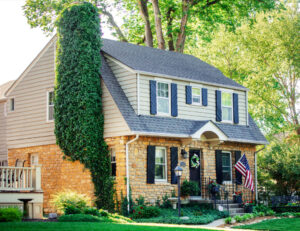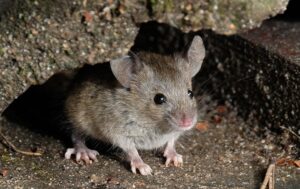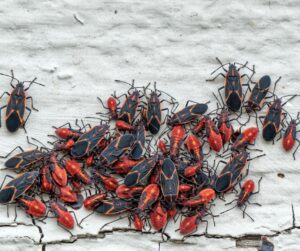The most common types of wasps and hornets in Kansas include different variants of the Yellowjacket wasp, Paper wasp, Mud dauber wasp, the European hornet, Baldfaced hornet, and the Cicada killer wasp.
Yellowjacket wasps: Yellowjacket wasps are probably the species you think of when someone says ‘wasp’ and are among the most common species of stinging insect. They are usually about half an inch long, and have a largely yellow body, with black markings. Since this type of wasp is a scavenger, they are attracted to areas that contain waste, particularly food waste and sugary drink cans. Yellowjackets typically build their nests underground, rather than suspended in the air like many other wasp and hornet species.
Paper wasps: The different types of paper wasps in Kansas range from about 0.7 inches to 1 inch long, and are distinguished by their long legs and beige, maroon, and black body. This type of wasp builds its nest from the eaves of buildings or in other semi-sheltered spaces, such as barns or stables. Unlike the yellowjacket wasp, this species isn’t aggressive by nature, and unless the nest is a major inconvenience, it’s recommended that you leave them to it.
Mud dauber wasps: Mud dauber wasps vary the most in length of the species listed here, ranging from 0.5 to 1.25 inches long. They can be recognized by their comparatively slim frame, and most of their body is black compared to the other species of wasp and hornets in Kansas listed here. While this type of wasp is not typically aggressive, it’s often necessary to employ pest control to remove their nests, since they build nests made out of mud (which often starts to smell) in protected, sheltered areas, meaning that these nests are often built near human residencies.
European hornets: The European hornet is roughly 1.2 inches in length, and typically has a thicker body than the other wasps in Kansas; its body is black and red, with yellow hindquarters. It nests in logs, hollow trees, or in buildings, and they cover their nests with wood fibers. Though fearsome looking, this hornet isn’t typically aggressive, and it’s therefore recommended that they be left alone unless their nesting activity is causing a problem.
Baldfaced hornets: Arguably the easiest wasp or hornet to identify in Kansas, the Baldfaced hornet is uniquely black and white. Its nest is also easily distinguishable, as its form is distinctly pear-shaped and hangs from the eaves of a building, or from the branch of a tree. Similarly, it’s best to leave these stinging insects alone unless they are close enough to human activity to be a hazard since they aren’t overly aggressive.
Cicada killer wasps: The largest species of wasp in Kansas, Cicada killer wasps range from 1.5 inches to a whopping 2 inches long, and have brown and black bodies. Despite their intimidating size, cicada killers (perhaps surprisingly) aren’t aggressive as a species and are only likely to sting if they are grabbed, or squashed against your skin. They build their nests underground and unfortunately create a muddy mess when doing so, which is why pest control is often called to deal with this species. However, they are actually quite a beneficial insect, since they help to control the cicada population, so wasp control and wasp nest removal aren’t recommended.

































